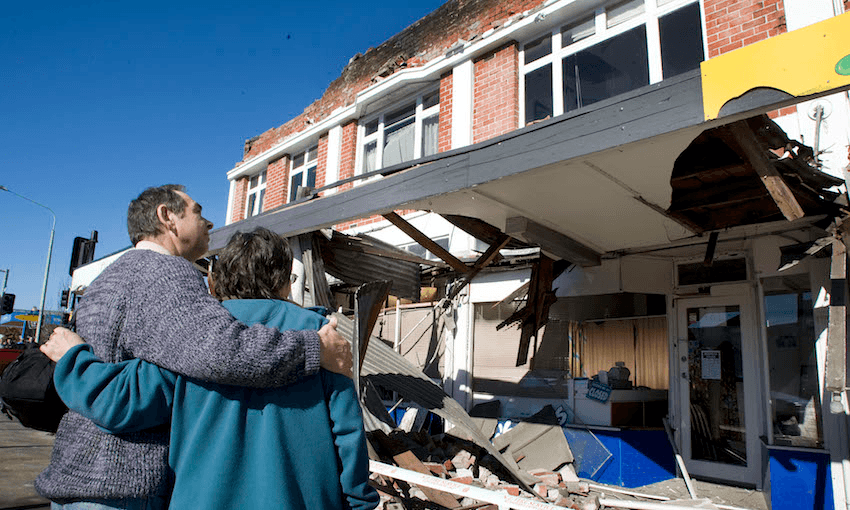Social scientist Lucy Carter says people’s resilience and generosity during the 2010 and 2011 Canterbury earthquakes spurred her to look at how Māori and indigenous communities respond to disaster.
When I tell people I’m a disaster researcher, I tend to get a range of reactions. Some take the opportunity to share with me their personal stories of experiencing disasters in Aotearoa, which, let’s face it, most of us have. Our country’s unique hazardscape means we’re at risk from earthquakes, floods, tsunami, storms, volcanos, droughts and fire, to name a few. Other times I get technical questions, particularly around earthquakes: ‘So when’s the big one going to be then?’ There’s disappointment when I can’t respond with a definite ’18th of May 2022′. Occasionally, people will let me know that they’re ‘tired of you scientists scaremongering all the bloody time’, and if a big one happens they’ll sit on their roof with a glass of wine and wait for it to roll in. Whatever their angle, people are usually pretty keen to offer me a response based on their personal experience or knowledge. Alternatively, when I introduce myself as a Māori disaster management researcher I get a different response – ‘Oh that’s really interesting… what does it mean?’
I currently live in Pōneke but I am originally from Ōtautahi. The 2010 and 2011 earthquakes happened while I was a sociology student at the University of Otago, and I was staying with my whānau in Ōtautahi in September 2010. In so many ways, the event remains a bookend in my personal and academic life. It remains the single scariest thing I’ve experienced, but also one of the proudest. We managed to pull together, we checked on our neighbours, the rūnanga manned the hotline while marae opened to manaaki anyone who needed assistance.
While the September earthquake was a jarring experience, the February 2011 quake was emotionally devastating for Ōtautahi. I was back in Ōtepoti at the time, and reliant on the news and social media for information. The Ngāi Tahu Facebook page was a flurry of information, with people offering support and shelter, as well as pinpointing hazard information, road access and people who needed assistance. I remember the (admittedly limited) news coverage of Tā Mark Solomon describing the work that Ngāi Tahu and other iwi were doing collectively to help respond to the earthquakes. Ngāi Tahu people were out and about helping their neighbours in suburbs across the city. Everyone wanted to do something to help someone else, no matter who they were or where they came from. Aroha ki te tangata.
The disaster response that was organised by Māori was a captivating and positive story amongst a slow and arduous recovery process. Our kaupapa, our tikanga and our mātauranga Māori had made our people really effective at responding to disasters. As tangata whenua of Aotearoa we have a long and intimate history with the whenua and the moana and all the hazards they can throw at us. It is this history that we have passed down throughour whakapapa – our mātauranga Māori along with our tikanga – that make us resilient. Responding to disasters is what we do and we do it well.
I have been privileged to have had many opportunities in my academic career to work with Maōri and indigenous people in the disaster space. Whether it has been designing tsunami education activity kete for kura kaupapa Māori students, sitting down with kaumātua to discuss marae resilience and mātauranga Māori over cups of tea or more broadly, the inclusivity of indigenous people and indigenous knowledge into mainstream disaster management policies, the generosity, intelligence and spirit of the people I have worked with so far has been deeply humbling. While the subjects of my research have been diverse, the heart of my research comes back to what I learned from the 2010 and 2011 Canterbury earthquakes.
The response of our people to the earthquakes and to other disasters is part of my whakapapa now and it will be passed on down through my whānau. While the earthquakes brought a lot of pain and tragedy, the effects of which are still being acutely felt by many very close to me, there is a positive kōrero that we can all learn: how we can respond to disasters, care for our communities and do so within our own tikanga and kaupapa frameworks. So when people want to know more about what Māori disaster management research entails I tell them what I have learned – it is about our unique capacity as a people to respond to a disaster. That from kura to kaumātua we have an abundance of knowledge and cultural expertise that needs to be validly recognised and shared for a more disaster-resilient Aotearoa. I may not be able to tell you the exact date of the next “big one” but I am pretty confident in the kaupapa that will be needed for us to respond to it- “aroha ki te tangata love to all people.”
